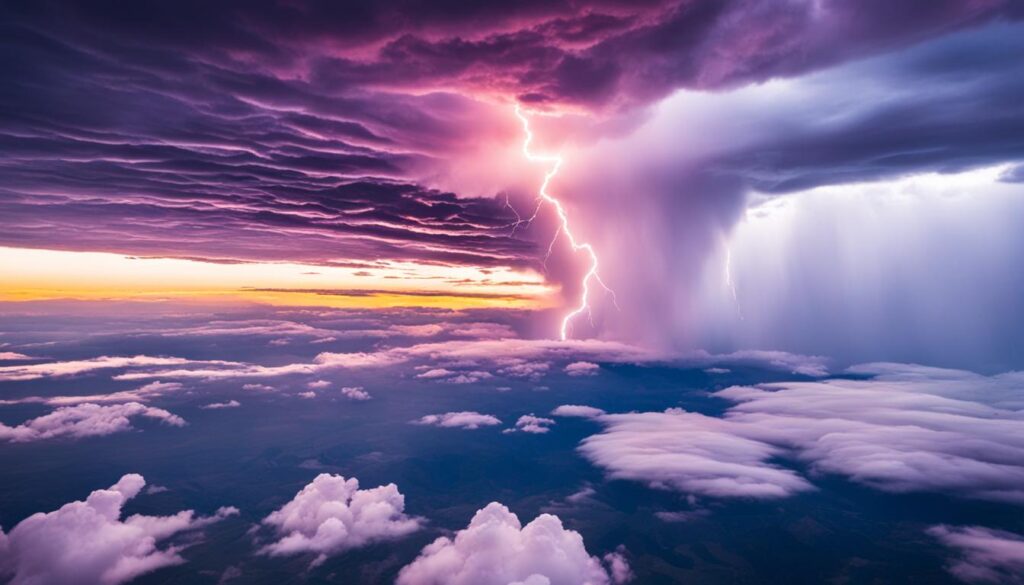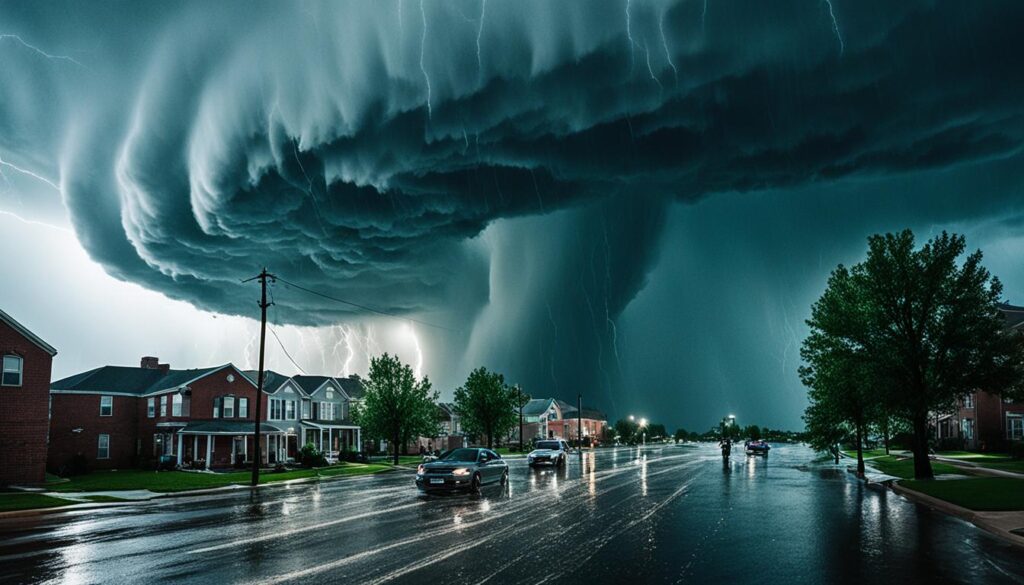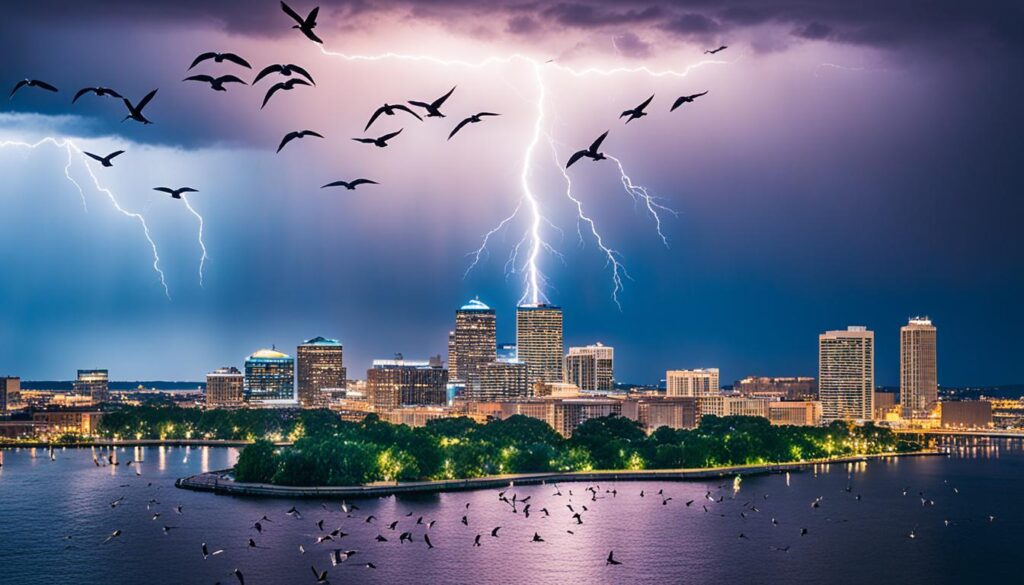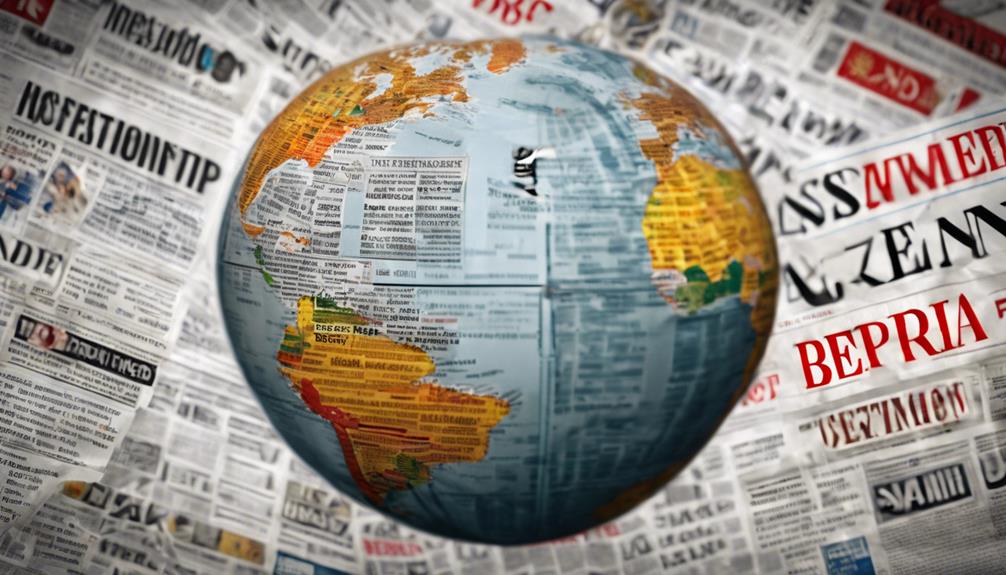As the sun sets on a warm summer evening, excitement fills the air at busy airports. Families look forward to reaching their destinations. But, many don’t know that this time of day can bring weather challenges.
Summer flights symbolize hope and adventure, but the weather can change fast. Meteorologists advise everyone to stay alert. They explain how hot temperatures and humidity make flying tricky. It’s important to keep weather safety in mind during our travels.
Key Takeaways
- Summer evening flights are often affected by rising temperatures.
- Increased humidity levels can lead to unpredictable weather patterns.
- Understanding meteorological risks is essential for safe travel.
- Awareness of thunderstorm activity is crucial for evening travel.
- Travelers should prepare for potential delays due to weather conditions.
Understanding Summer Weather Patterns
Summer brings unique weather patterns that change how we go about our day, including flying. As it gets hotter, those flying should know how weather affects flights. The rise in temperature also makes the air more humid, which is uncomfortable and can make flying riskier.
Changes in Temperature and Humidity
During summer, we see big changes in temperature, which affects humidity. Because warm air can hold more water, it gets stickier and less comfortable for us. This high humidity can also affect how well airplanes perform.
More humidity means planes might have trouble during takeoff and landing. Pilots need to adjust for these issues, which might cause delays.
Increased Thunderstorm Activity
Summer is well-known for its thunderstorms. These storms are becoming more common and can disrupt flights suddenly. They come quickly and put safe flying at risk.
Because of these storms, flights might be delayed, cancelled, or have to go a different way. It’s smart to keep an eye on the weather for any updates.
Why You Should Avoid Summer Evening Flights, According to Meteorologists
Summertime means more people are flying in the evenings. But meteorologists warn there’s a good reason to rethink this. Evening flights are riskier due to flight safety concerns. This is because the heat builds up all day. This can lead to more thunderstorms and turbulence for those flying at night.
Impact of Rising Temperatures on Flight Conditions
The heat grows throughout the day, causing more humidity. This makes the air unstable, which isn’t good for evening flights. When the sun goes down, the day’s heat causes thunderstorms to form. This increases the chance of encountering rough air, making flights uncomfortable and raising safety worries. Meteorologists say that this pattern means evening flights often get delayed by thunderstorms, messing up travel schedules.
Heightened Risk of Turbulence During Evening Hours
Evenings see more thunderstorms than mornings because the air is still warming up. This keeps the risk of turbulence high. Sometimes, storms don’t need to hit directly where you’re flying from or to. They can still cause delays. And those delays can pile up, affecting many flights. Meteorologist Chris Bianchi suggests using FlightAware or Flightradar24 apps to watch flight paths. This could help avoid some weather delays. Flying in the morning lowers the risk of these problems.

The Effects of Climate Change on Weather Conditions
Climate change deeply affects weather, especially for air travel. Scientists have linked warming to more extreme weather events. This creates dangerous flying conditions.
More Frequent and Intense Weather Events
Studies show a spike in severe weather because of climate change. Warmer oceans lead to stronger storms and hurricanes. The Gulf of Maine warmed by about 1.6 degrees Celsius since the 1980s. This has caused more intense marine heat waves in the last 10 to 15 years. Thus, air travel faces more risks as storms can quickly form and change plans.
The Role of Climate Indicators in Seasonal Weather Forecasts
Meteorologists use climate indicators to improve forecast accuracy. They look at past data to predict weather changes. This helps foresee travel disruptions. For example, changes in puffin breeding on Machias Seal Island indicate climate shifts. This shows the link between climate change and travel safety. It highlights staying updated with forecasts.

| Impact | Before Climate Change | Current Situation |
|---|---|---|
| Frequency of Hurricanes | Less frequent | More frequent and intense |
| Marine Heat Waves | Occasional | Common and prolonged |
| Weather Pattern Stability | Stable | Unpredictable |
| Forecasting Accuracy | Moderate | Improving with climate indicators |
Safety Precautions for Summer Evening Travelers
Summer evening flights can be tricky, making it crucial to focus on safety. Being proactive helps handle issues like unexpected weather, which can cause delays or changes in flight paths. Here are key steps for a safer journey.
Checking Weather Forecasts Before Travel
Before you travel in the summer, staying updated with the weather is key. Weather can change quickly, so it’s smart to check reliable weather sources for any possible impacts on flights. Being informed about the weather helps you prepare for any travel interruptions.
Understanding Potential Delays and Re-routing
Delays are more common in the summer, especially in the evenings. Knowing that delays might happen, you can make flexible travel plans. Having a backup plan for getting rerouted can reduce stress and help you get to your destination without major issues. Preparing for unexpected changes makes handling them much easier.

| Tip | Description |
|---|---|
| Monitor Weather Updates | Check forecasts regularly leading up to your flight to anticipate potential issues. |
| Flexible Itinerary | Create a travel plan that allows for adjustments in case of delays or cancellations. |
| Contact Airlines | Stay connected with airlines for real-time updates about flight statuses. |
| Arrive Early | Allow extra time at the airport to handle any unforeseen circumstances. |
| Prepare for Delays | Pack essentials like snacks and devices to stay comfortable during wait times. |
Conclusion
Summer evening flights face more risks due to weather, such as high humidity and thunderstorms. Meteorologists suggest keeping an eye on weather updates. This helps travelers plan better and stay safe.
Climate change is making weather more unpredictable, affecting flights more. It’s smart to consider how higher temperatures and turbulence can impact evening flights. Being well-informed helps travelers manage their journeys better.
Being proactive about air travel is key in dealing with today’s changing weather. Knowing about the risks of summer evening flights can improve travel safety. A knowledgeable traveler is always a safer one.










